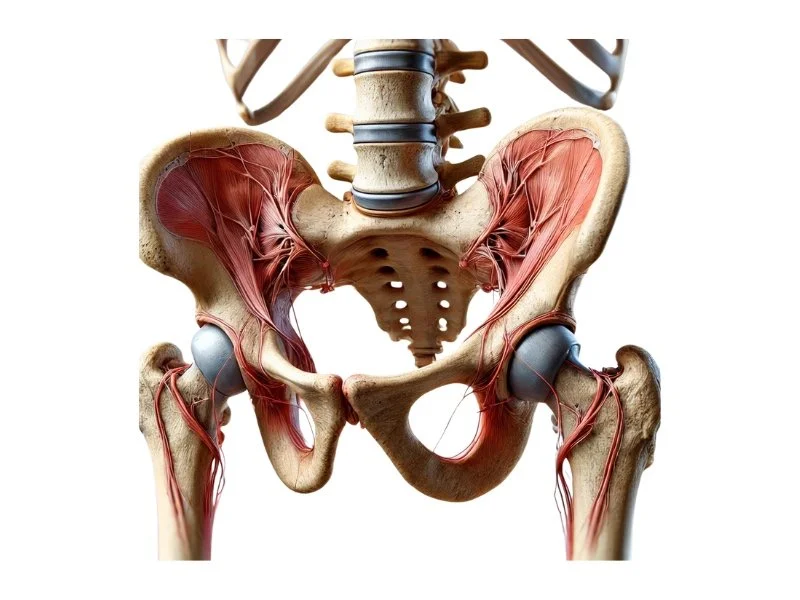The Sacroiliac Joint: A Key Player in Women’s Health and Pelvic Floor Function
When it comes to women’s health, the sacroiliac joint (SIJ) often goes unnoticed—despite its crucial role in connecting the spine to the pelvis and supporting movement and stability. Positioned between the sacrum and the pelvic bones on either side, the SIJ acts as a crucial bridge, transferring load from the lumbar spine to the lower extremities. While low back pain (LBP) is commonly attributed to the lumbar spine, a significant portion of LBP cases may actually stem from dysfunction in the SIJ. Understanding the anatomy and biomechanics of the SIJ, its connection to the pelvic floor, and its role in women’s health is key to addressing this often-overlooked source of discomfort and often pain.
Anatomy and Biomechanics of the SIJ
The SIJ is a robust structure designed to transfer large bending moments and compression loads from the upper body to the legs. It achieves stability through the tight wedging of the sacrum between the hip bones and support from surrounding ligaments. Despite its strength, the SIJ allows minimal motion: approximately 3° in flexion-extension, 1.5° in axial rotation, and 0.8° in lateral bending. This limited mobility helps maintain structural stability but also makes the joint susceptible to dysfunction if subjected to abnormal stresses.
Women’s Health: Sexual Dimorphism and the SIJ
Women’s pelvises are wider and less curved than men’s, with a sacrum that is more posteriorly tilted. These anatomical differences contribute to increased SIJ mobility and higher ligamentous strain, especially during times of hormonal changes such as pregnancy. While this flexibility is advantageous for childbirth, it can also leave women more vulnerable to SIJ-related pain and instability. Hormonal shifts during pregnancy can further increase ligament laxity, altering SIJ dynamics and contributing to discomfort.
Causes of Sacroiliac Joint Pain
SIJ pain can arise from a variety of factors, including:
Hypo- or Hypermobility: Restricted or excessive movement of the joint.
Extraneous Forces: Compression or shearing forces applied to the joint.
Tissue Injury: Ligament sprains, muscle strains, or soft tissue inflammation.
Structural Imbalances: Issues such as leg length discrepancies or prior lumbar spine fusions.
Inflammation: Disorders such as sacroiliitis.
Studies suggest that the SIJ may be the source of pain in up to 30% of LBP cases, making it a critical focus for both diagnosis and treatment.
The SIJ and Pelvic Floor Connection
The relationship between the SIJ and the pelvic floor is deeply interconnected. The stability and alignment of the SIJ directly influence the tension and function of the pelvic floor muscles. Dysfunctions in the SIJ, such as hypo- or hypermobility, can create imbalances in the pelvic floor, leading to issues like tension or weakness. Over time, these imbalances may contribute to pelvic organ prolapse (POP), a condition where weakened pelvic floor muscles fail to adequately support the pelvic organs.
Low back pain originating from the SIJ may be an early indicator of pelvic floor dysfunction or POP. This highlights the need for a holistic approach to SIJ-related pain, including both pelvic floor and SIJ stabilisation exercises for long-term health and wellness.
The Role of Breath and Pelvic Dynamics
The SIJ functions as part of a wider network involving the pelvis, lumbar spine, and thoracic diaphragm. Breathwork practices like Hypopressives and 360° costal breathing can positively influence this interconnected system by:
Improving Load Distribution: Balancing intra-abdominal pressure to reduce stress on the SIJ.
Enhancing Stability: Engaging deep core muscles, including the pelvic floor, to support the joint.
Supporting Mobility: Promoting healthy, rhythmic movement in the sacroiliac region.
Supporting the SIJ: Exercises for Strength and Stability
Targeted exercises can help alleviate SIJ pain and improve its function. One effective movement is the Lying Hip Adduction:
How to Perform Lying Hip Adduction
Lie on your back on a comfortable surface with your knees bent and feet flat on the ground.
Place a medium exercise ball (about the size of a dodgeball or a small inflatable pilates ball) between your knees.
Squeeze the ball gently with your knees for 5 seconds, then release.
Add a Hypopressive Breath Cycle:
Inhale as you release the ball.
Exhale as you squeeze, holding the gentle squeeze as you perform the apnoea or continue with lateral costal breathing if you haven’t yet learned the apnoea.
Repeat 10 times to strengthen the hip adductors and lower abdominal muscles.
This exercise not only supports the SIJ by strengthening surrounding musculature but also integrates breathwork to engage the pelvic floor and core.
Conclusion
The sacroiliac joint is a foundational component of women’s health, linking the spine to the pelvis and influencing the function of the pelvic floor. Acknowledging its role in low back pain and pelvic organ support is essential for addressing these interconnected issues. By incorporating breath-work, targeted exercises, and a holistic understanding of pelvic dynamics, women can achieve improved SIJ function, enhanced pelvic floor health, and overall well-being. Working with this often-overlooked joint is a step toward a stronger, more balanced body.
